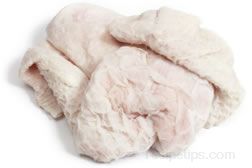Before it is sold, tripe is thoroughly washed and it is often bleached. Because it is extremely tough and requires lengthy periods of slow cooking to tenderize it, tripe is sometimes sold partially cooked to save time for the home cook. Tripe can be cooked as is and served as a main dish or it can be added to casseroles and stews.
Although for many people tripe may not be very appetizing, it was traditionally eaten by people with limited resources who desired to waste as little from the animal as possible. It eventually caught on as a delicacy and many famous recipes where the result: in Mexico, a soup known as menudo is very popular; pepper pot soup, which is a tripe soup made with peppercorns, originated in the Eastern United States; tripe and onions is a common dish in England; and Tripes à la mode de Caen is the most famous of the many tripe recipes from France.








